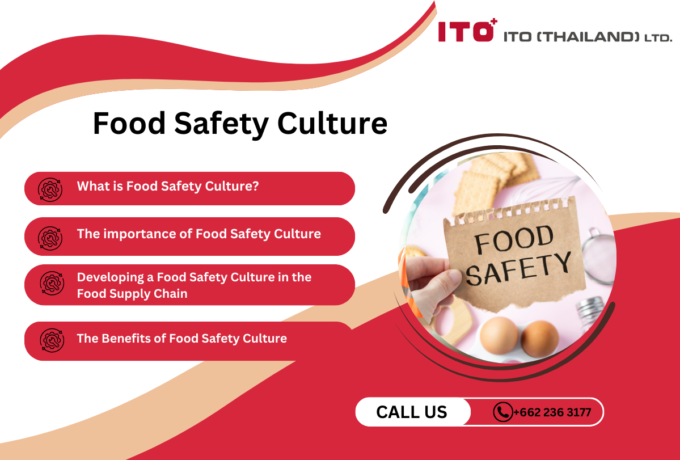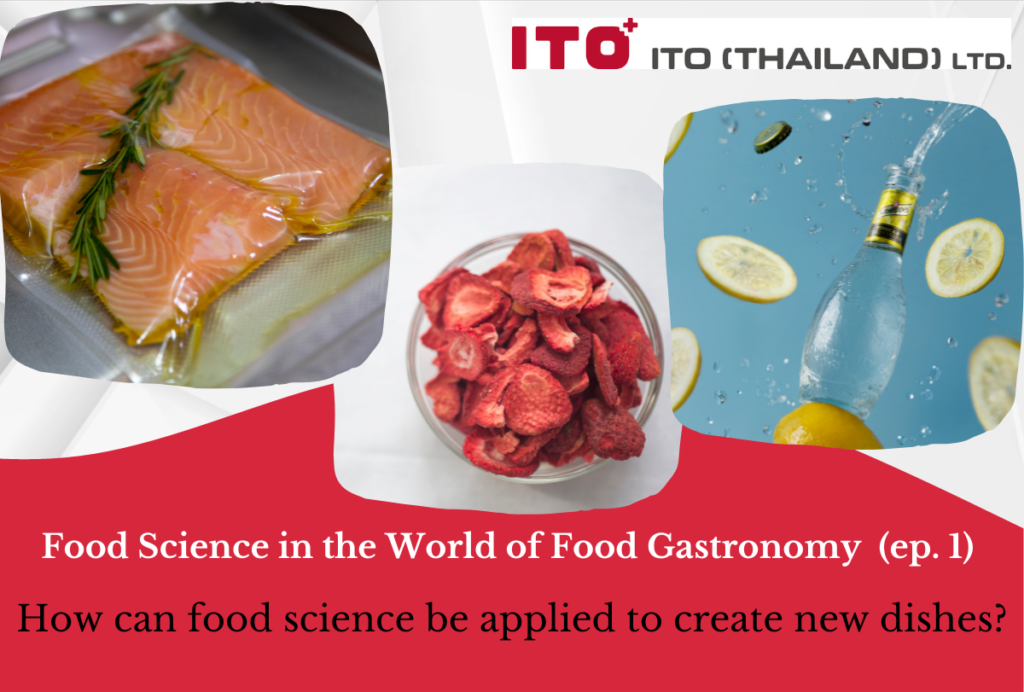ITO Thailand Hygiene Blog
Food Science in the World of Food Gastronomy (Part 1)
How can food science be applied to create new dishes?
Knowledge of science and technology is applied in food gastronomy at present as the basis for creating new cooking techniques called Molecular Gastronomy. It includes changes in appearance, texture, flavor, etc., to provide impressive new experiences for consumers.
Today, we will show you examples of some of the new techniques of molecular gastronomy and the science behind these techniques.
•Sous vide
Sous vide is a technique for cooking food in a vacuum bag at a temperature lower than normal cooking. It is the use of basic food science knowledge that the state of vacuum can control the food to have the desired properties due to various reasons: Prevented oxidation resulting in reduced off smells, inhibition of the evaporation of water and aroma-active compounds in food and microorganisms that need air to grow, making it possible to kill pathogenic microorganisms at lower temperatures than conventional atmospheric pressure pasteurization [1]. In addition, temperature affects changes in food quality that may be undesirable, such as loss of flavor, loss of texture, loss of heat-sensitive functional substances. The use of lower temperatures also reduces these changes in quality. However, the use requires knowledge of temperature control to avoid the temperature range suitable for microbial growth.
•Spherification
Spherification or creating gel balls with liquid inside encased in a gel film. It uses the knowledge about the properties of alginate that forms a gel when exposed to calcium and encapsulates the liquid inside the gel, enabling fluid retention (encapsulation) and give a new sensation to consumers, such as artificial fish roe, juice caviar, salad dressing gel or various sauces, alcoholic drink gel, or used as a material for designing zero-waste packaging for drinking water, etc. At present, there is further development where spherification technique is applied in conjunction with 3D printing to create new designs of liquid retention gels in addition to balls, such as stars, squares, letters, or complex color-changing designs [2].
•Ultrasound wave
Ultrasound is a supersonic frequency that is inaudible to humans but produces vibrations that are useful for altering food properties. Examples include flavor extraction, creation of microscopic air bubbles within the liquid (Read more about micro-bubbles in food: Part 1, Part 2), aid in the dispersion and mixing of ingredients, e.g., in nanoemulsions [3].
•Flash freezing
Flash freezing using liquid nitrogen is used to cool food temperatures rapidly without the formation of large ice crystals. This is because of the rapid heat transfer from liquid nitrogen at extremely low temperatures, resulting in solid food that can maintain weak structures, such as foam/bubble structures. Protection against water and oil separation helps to reduce the time to wait for the food to cool down. Moreover, new foods such as ice cream pellets are created by dropping tiny drops of milk or fruit juice in liquid nitrogen. In this regard, liquid nitrogen has no health effects and can quickly evaporate into gas. However, caution must be taken when mixing liquid nitrogen with food that may contain remaining liquid nitrogen because the viscosity of the food slows evaporation, and it may be harmful to the oral cavity. It should also be used in an open or well-ventilated area to prevent oxygen deprivation due to excessive liquid nitrogen density.
•Foaming, Espuma & carbonation
High-pressure carbonation is a technique for adding new texture to food, such as making soft drinks or sodas with carbon dioxide or even making carbonated solid food items, such as carbonated fruit pieces that have a soda-like texture. This uses the knowledge about increasing gas dissolution with pressure. If the same principle is applied by adding gas bubbles to viscous liquids together with adding additives that can retain air bubbles well, it will create the texture of food in the form of foam or mousse (A well-known example is whipped cream or mousse cake), foamy and creamy fruit juices, sauces, or even protein in a liquid form like cream soup. This results in a light texture and viscosity when swallowed. Currently, this technique is also being used to help design food textures for people with specific needs such as the elderly who have difficulty chewing and swallowing food [4].
These are some examples of how food science and technology combine with culinary creativity to create new and interesting menus for consumers. The constant development is in parallel with exploring new knowledge and technology because the destination of science and technology is the design of products that consumers can actually use. In addition to the techniques mentioned above, there are many other interesting techniques that we will share with you at the next opportunity. Please stay tuned at ITO Thailand’s Facebook page and blog.
References
1.Baldwin, D. E. (2012). Sous vide cooking: A review. International Journal of Gastronomy and Food Science, 1(1), 15-30.
2.D’Angelo, G., Hansen, H. N., & Hart, A. J. (2016). Molecular gastronomy meets 3D printing: Layered construction via reverse spherification. 3D Printing and Additive Manufacturing, 3(3), 152-159.
3.Sivakumaran, K., & Prabodhani, W. D. M. H. (2018). An overview of the applications molecular gastronomy in food industry. International Journal of Food Science and Nutrition, 3(3), 35-40.
4.Koizumi, A., Koizumi, A., & Mineki, M. (2023). Preparation and suitability of espuma fish dishes for older adults. Food Science and Technology Research, 29(3), 247-256.
Related Post
-

Food Safety Culture
Food safety culture plays a crucial role in safeguarding the company's reputation, ensuring the well-being of its employees, and providing a safe experience for its customers.
-

New food source safety issues
What are safety issues worth knowing for trendy new food sources like plant-based and insect-based proteins?
-

British Retail Consortium (BRC) Standard
Food safety management systems play a vital role in ensuring the production and distribution of safe and high-quality food products to consumers. With the global food supply chain becoming increasingly complex, food businesses must implement effective systems prioritising safety, quality, and compliance with industry standards. A food safety management system encompasses a set of procedures, processes, and controls designed to identify, prevent, and manage potential hazards at every stage of the food production and supply process. This proactive approach not only safeguards consumers' health but also protects the reputation and credibility of food companies in an ever more competitive market.
-

FSSC 22000
Food manufacturers must ensure food safety standards and processes. FSSC 22000 is an official certification program for Food Safety Management Systems (FSMS) recognised by the Global Food Safety Initiative (GFSI). This certification scheme offers a set of guidelines and procedures to ensure uniformity, openness, and safety across your entire supply chain. It applies to all companies operating within the food and beverage industry, ranging from farmers to retailers. By fulfilling the necessary criteria and obtaining FSSC 22000 certification, it is demonstrated that the required standards for food quality and implementing effective processes to manage and mitigate risks associated with food fraud, foodborne illnesses, expensive recalls, and other external threats are met.
-

Food Safety Aspects of Artificial Sweeteners
Artificial sweeteners, also known as sugar substitutes, non-nutritive sweeteners, or high-intensity sweeteners, are artificially produced compounds utilised in place of sucrose (table sugar) to add sweetness to food and drinks. Due to their significantly higher sweetness than regular sugar, only a fraction of artificial sweeteners (200 to 20,000 times less) is required to achieve an equivalent level of sweetness. Since the caloric contribution of these sweeteners, when used in such small quantities, is insignificant, they are often referred to as non-nutritive (4).
-

New food sources from under the sea
A new sustainable food source that is environmentally friendly and addresses resource scarcity issues, which is currently trendy! Let's get acquainted with the new food sources from the underwater world, such as seaweed and jellyfish.










